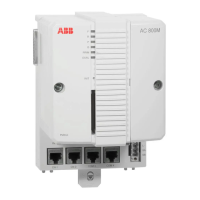Section 3 Parameter Interface Initial value
3BSE042835-600 31
• No Right - Not visible as a port. The parameter will be placed on the right side
of the object if the user decides to show it later on.
• Yes - Visible as a port on the left side of the object.
• Yes Left - Visible as a port on the left side of the object.
• Yes Rig ht - Visible as a port on the right side of the object.
Initial value
The initial value column for a parameter can be: empty, a value, or the value default.
The value default is only applicable to Control Modules and Diagrams.
Parameters with type description IN or IN(OUT) can have all three alternatives;
empty, a value, or the value default. For parameters with type description OUT and
OUT(IN) either the empty field alternative, or the value default, is used. An empty
initial value of a parameter of direction In_Out forces the application engineer to
connect a variable to it, and the parameter then receives this parameter's initial
value. Parameters marked default receives the initial value of its type.
For simple data type, it is advisable to use default only for out parameters. For
structured data types it may be used both for in and out. For in parameters of simple
data types it is advisable to instead use the intended default value example, false for
a bool parameter.
The initial value of an instance can be set using the Control Properties aspect in the
Control Structure of the Plant Explorer Workplace. This is, for example, useful for
InteractionPar.
Description
Parameters in object types should have a line of text briefly describing its
purpose/function. If a short name has been used for the parameter, use the
description field to explain it with full names. For example, the description field for
the parameter PrtAckAlarms may look like “Prints acknowledged alarms”. A real or
integer input parameter may have a range. When the parameter value is out-of-range
the parameter shall be assigned a specific value or the last good value.

